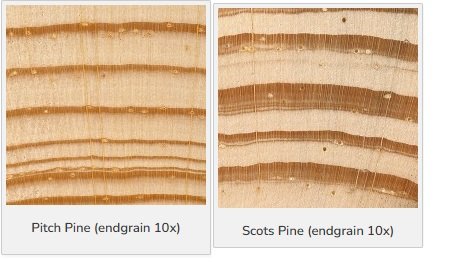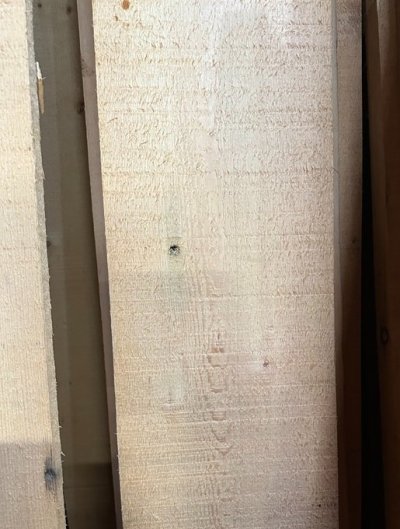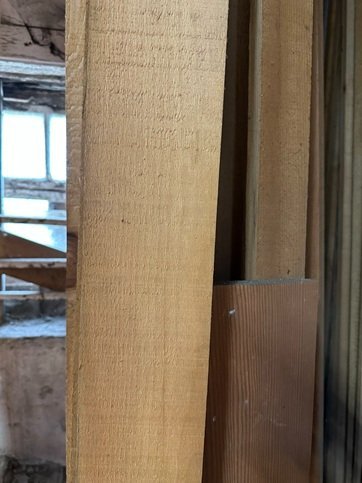You are using an out of date browser. It may not display this or other websites correctly.
You should upgrade or use an alternative browser.
You should upgrade or use an alternative browser.
Help with pitch pine shutters
- Thread starter lorenzoli
- Start date
Matt Green
Member
- Messages
- 718
I'm not surprised, Pinus rigida was always incredibly expensive, but people get tetchy when it's suggested their timber is far more likely to be slow-grown, good quality, Scots pine. Whilst that might be true for the structural timbers that I tend to look at, Toby Newell said that he came across it quite regularly and that would also make sense in that he would: a) look at more floorboards than me and in more detail, and b) be likely to be able to tell the difference by sight or smell.
Anyway, essentially, rather than look for the age of the timber, I would be inclined to look for Scots pine with the same growth rate. It doesn't matter when the tree was felled, but if you try to match the number of growth rings per unit area to the existing timber, then it should behave in the same way with changes in temperature and humidity.

Image credits: https://www.wood-database.com/
Anyway, essentially, rather than look for the age of the timber, I would be inclined to look for Scots pine with the same growth rate. It doesn't matter when the tree was felled, but if you try to match the number of growth rings per unit area to the existing timber, then it should behave in the same way with changes in temperature and humidity.

Image credits: https://www.wood-database.com/
Scandinavian redwoood/ Scots pine seems to be hard to find at a reasonable price (I had one option for £215 per m2!)Interesting - scots pine (pinus sylvestris) is the stuff you'll find in most timber yards, commonly referred to as redwood. Timber naming is a minefield! However, that means that you'll find what you need almost anywhere - but I'd urge you to seek out a proper timber merchant who'll offer much better quality stuff than anything you'll find in any of the sheds.
What do you think of old Yellow pine instead?
Thanks
Cubist
Member
- Messages
- 3,309
- Location
- Shropshire/Herefordshire Border
Dumb question perhaps but.... how many visitors to your home would be able to tell the difference and how many of them would be rude enough to point out any error on your part?
fernicarry
Member
- Messages
- 834
- Location
- Argyllshire
You could try timbercut4u. Their pricing scheme is a bit odd because they apportion the cost of the "free" delivery across the basket so the more you add the cheaper each piece becomes. I've found the quality of their redwood pine to be pretty decent (for modern stuff).
Another suggestion would be to use reclaimed internal doors as a source of timber. You'd probably get a better match in terms of its characteristics but you won't quite get the 8' length you are looking for.
Another suggestion would be to use reclaimed internal doors as a source of timber. You'd probably get a better match in terms of its characteristics but you won't quite get the 8' length you are looking for.
Thanks a lotYou could try timbercut4u. Their pricing scheme is a bit odd because they apportion the cost of the "free" delivery across the basket so the more you add the cheaper each piece becomes. I've found the quality of their redwood pine to be pretty decent (for modern stuff).
Another suggestion would be to use reclaimed internal doors as a source of timber. You'd probably get a better match in terms of its characteristics but you won't quite get the 8' length you are looking for.
Yes I was advised to also search for reclaimed doors.
That's not dumb at all.Dumb question perhaps but.... how many visitors to your home would be able to tell the difference and how many of them would be rude enough to point out any error on your part?
The more I search the more I know that I won't find what I'm looking for because 95% of reclaimed wood seems fake, and matching exactly what I have is impossible.
So I will hide the differences
Only important thing is to get old enough reclaimed boards in pine (any pine!) so when I fold/unfold the shutters I don't notice tooo much of a difference
I thought I had found a solution in Bolton but it's from reclaimed beams and I was told not to use resawn beams for shutters because there is zero patination and there are poor wood with poor stability not meant for joinery and colour is zero.
That's not dumb at all.Dumb question perhaps but.... how many visitors to your home would be able to tell the difference and how many of them would be rude enough to point out any error on your part?
The more I search the more I know that I won't find what I'm looking for because 95% of reclaimed wood seems fake, and matching exactly what I have is impossible.
So I will hide the differences
Only important thing is to get old enough reclaimed boards in pine (any pine!) so when I fold/unfold the shutters I don't notice tooo much of a difference
I thought I had found a solution in Bolton but it's from reclaimed beams and I was told not to use resawn beams for shutters because there is zero patination and there are poor wood with poor stability not meant for joinery and colour is zero.
I now look for any boards old enough (ideally late Georgian/early Victorian time but at least 100 years old) in pine (ideally in Baltic pine or Scandinanvian redwood but now any pine will do) to match with what I kept from my old shutters.A quick look online shows redwood planks that meet your spec in the first few posts for £8 plus delivery per 2.4m plank. Are you asking for non-standard plank thicknesses or widths that would require additional ripping / milling?
Main difficulty is the 25mm thickness because my shutters fold into deep reveals.
I have a carpenter to adjust. I just need some good timber.
Any reliable place you can point me to would be super helpful.
From your post I understand those offers (£8 plus delivery) it's recent redwood right? That would be my last option.
Itchinfilth
Member
- Messages
- 140
- Location
- Bingley
Admire your commitment to use the exact types of period timber used originaly in your house. I'm exactly the same but sometimes due to cost / lack of availability you sometimes need to take the hit and compromise. I can honestly say that in the few occasions I've compromised, it's not really crossed my mind once they are in place 
eezageeza
Member
- Messages
- 152
- Location
- Shropshire
I think that price is per cubic metre (yep, timber trade pricing is a bit esoteric!)Scandinavian redwoood/ Scots pine seems to be hard to find at a reasonable price (I had one option for £215 per m2!)
What do you think of old Yellow pine instead?
Thanks
eezageeza
Member
- Messages
- 152
- Location
- Shropshire
Resawn beams should be pretty stable - the wood is obviously old, and well dried. The resawing process can result in the release of internal tensions in the wood (= warping) but this will be evident in the resawn planks, so can be sorted out.That's not dumb at all.
The more I search the more I know that I won't find what I'm looking for because 95% of reclaimed wood seems fake, and matching exactly what I have is impossible.
So I will hide the differences
Only important thing is to get old enough reclaimed boards in pine (any pine!) so when I fold/unfold the shutters I don't notice tooo much of a difference
I thought I had found a solution in Bolton but it's from reclaimed beams and I was told not to use resawn beams for shutters because there is zero patination and there are poor wood with poor stability not meant for joinery and colour is zero.
You are correct that the virgin wood exposed by resawing will have zero patination, but pine ages really quickly once exposed to light and air (in my experience, dramatically darker in just a year or two).
I know that I'll have to compromise!Admire your commitment to use the exact types of period timber used originaly in your house. I'm exactly the same but sometimes due to cost / lack of availability you sometimes need to take the hit and compromise. I can honestly say that in the few occasions I've compromised, it's not really crossed my mind once they are in place
Thanks for that insightResawn beams should be pretty stable - the wood is obviously old, and well dried. The resawing process can result in the release of internal tensions in the wood (= warping) but this will be evident in the resawn planks, so can be sorted out.
You are correct that the virgin wood exposed by resawing will have zero patination, but pine ages really quickly once exposed to light and air (in my experience, dramatically darker in just a year or two).
Yes I don't want the wood to "curve"
Probably getting old wood from flooring would still be safer though.
I also tried to look for old shutters or old doors on eBay but difficult to assess what is sold.
Hello
Need your insight
What do you think of that?: https://www.ebay.co.uk/itm/236283278615
Is it fake? (Chat GPT says it's late 19century/early 20th century so not Georgian time but that AI...)
I am also sharing couple of pictures of the Yellow pine (from resawn beams). Looks old. The lady said that the woodwork expert was wrong and it can clearly be used for shutters.
I think it can match with what I currently have
Thank you


Need your insight
What do you think of that?: https://www.ebay.co.uk/itm/236283278615
Is it fake? (Chat GPT says it's late 19century/early 20th century so not Georgian time but that AI...)
I am also sharing couple of pictures of the Yellow pine (from resawn beams). Looks old. The lady said that the woodwork expert was wrong and it can clearly be used for shutters.
I think it can match with what I currently have
Thank you


eezageeza
Member
- Messages
- 152
- Location
- Shropshire
They look fabulous from the photos! Impossible to tell whether they're fake or not without seeing them in the flesh of course, but its difficult to imagine someone would have such a random selection of shapes and sizes without them having been rescued from an old house. Personally I wouldn't get too hung up on eactly how old they are - if they tick all the other boxes for you, go for it!Hello
Need your insight
What do you think of that?: https://www.ebay.co.uk/itm/236283278615
Is it fake? (Chat GPT says it's late 19century/early 20th century so not Georgian time but that AI...)
Yellow pine is a different species to any others that have been discussed so far - its specifically from pine species grown in the USA. It would be perfectly good for your shutter project if you can get the right sizes, but it looks rather different to the timber in your shutters to me - much cleare(fewer knots) and more subtle grain.I am also sharing couple of pictures of the Yellow pine (from resawn beams). Looks old. The lady said that the woodwork expert was wrong and it can clearly be used for shutters.
I think it can match with what I currently have
Thank you
View attachment 17570
View attachment 17571
Timber merchant meaning recent/modern wood right?Interesting - scots pine (pinus sylvestris) is the stuff you'll find in most timber yards, commonly referred to as redwood. Timber naming is a minefield! However, that means that you'll find what you need almost anywhere - but I'd urge you to seek out a proper timber merchant who'll offer much better quality stuff than anything you'll find in any of the sheds.
I've found a few options from reclamation yards and hopefully one of them can work. I couldn't get scots pine but other types of pine about 100 years old.
Thank youThey look fabulous from the photos! Impossible to tell whether they're fake or not without seeing them in the flesh of course, but its difficult to imagine someone would have such a random selection of shapes and sizes without them having been rescued from an old house. Personally I wouldn't get too hung up on eactly how old they are - if they tick all the other boxes for you, go for it!
Yellow pine is a different species to any others that have been discussed so far - its specifically from pine species grown in the USA. It would be perfectly good for your shutter project if you can get the right sizes, but it looks rather different to the timber in your shutters to me - much cleare(fewer knots) and more subtle grain.
Yes I can get the right sizes
The other link (from eBay) won't work because my carpenter needs planks andnot shuters (+ very complex to bring to London)
